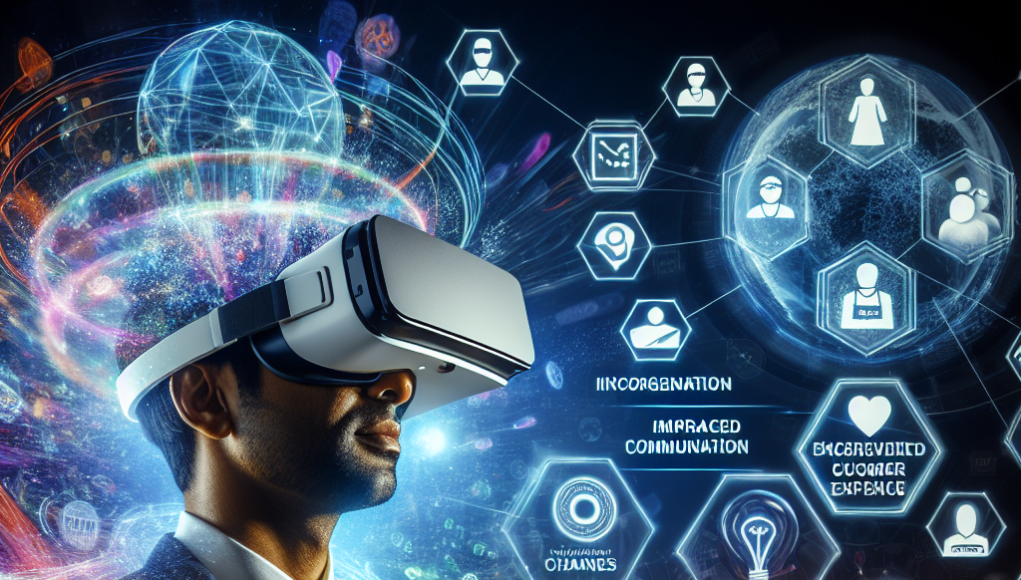In an era where digital innovation is reshaping the landscape of customer interaction, Virtual Reality (VR) technology emerges as a pivotal tool in enhancing customer experience. This immersive technology offers businesses a novel way to engage with consumers, providing a platform that combines interactivity with entertainment. As VR technology becomes more accessible and sophisticated, its potential to transform customer experiences is gaining attention across various industries. This article delves into the role of VR in customer experience, highlights the key benefits for both businesses and consumers, and outlines steps and best practices for effective implementation.
Exploring VR’s Role in Customer Experience
Virtual Reality technology is revolutionizing how businesses interact with their customers by offering immersive experiences that transcend traditional boundaries. By simulating real-life environments, VR allows customers to engage with products and services in a more meaningful way, enhancing their overall experience. Whether it’s a virtual tour of a real estate property, a test drive of a new car model, or a trial of a luxury vacation package, VR provides an opportunity for consumers to experience products and services before making a purchase decision. This ability to virtually ‘try before you buy’ can significantly influence customer satisfaction and decision-making processes.
Moreover, VR technology empowers businesses to create customized and personalized experiences for their customers. By leveraging data analytics and consumer insights, companies can tailor VR experiences to meet individual preferences and needs. This level of personalization not only enhances customer satisfaction but also fosters brand loyalty. For instance, retailers can use VR to create personalized shopping experiences, where customers can virtually browse and try on products in a setting that mimics their personal style and taste.
In addition to personalization, VR also plays a crucial role in storytelling and brand building. Companies can use VR to create compelling narratives that resonate with their audience, fostering a deeper emotional connection with the brand. For example, a travel company can use VR to transport potential customers to exotic destinations, allowing them to experience the sights and sounds firsthand. This immersive storytelling can enhance the brand’s image and create lasting impressions on consumers.
Furthermore, VR technology can significantly enhance customer service by providing virtual assistance and support. Businesses can employ VR to offer virtual walkthroughs, tutorials, and demonstrations, allowing customers to resolve issues and understand products better. This proactive approach to customer service not only reduces the need for human intervention but also ensures that customers receive consistent and high-quality support.
The adoption of VR in customer experience is also driven by its ability to create a sense of presence and engagement. Unlike traditional digital media, VR immerses users in a fully interactive environment, capturing their attention and encouraging active participation. This heightened level of engagement can lead to increased customer satisfaction and a more memorable experience, ultimately driving brand loyalty and advocacy.
Overall, VR technology is reshaping customer experience by offering immersive, personalized, and engaging interactions. As businesses continue to explore its potential, VR is set to become an integral part of the customer experience landscape, offering new opportunities for innovation and growth.
Key Benefits of VR for Businesses and Consumers
One of the primary benefits of VR for businesses is its ability to enhance product visualization and demonstration. By providing customers with a realistic and immersive experience, companies can showcase their products in ways that were previously unimaginable. This is particularly beneficial for industries such as real estate, automotive, and retail, where seeing a product in action can significantly impact purchasing decisions. Through VR, customers can explore a new home, test drive a car, or try on clothes without leaving their homes, making the shopping experience more convenient and enjoyable.
For consumers, VR offers a unique opportunity to engage with products and services on a deeper level. The immersive nature of VR allows users to experience products in a realistic setting, providing them with a better understanding of how the product fits into their lives. This can lead to more informed purchasing decisions and a higher level of satisfaction with the products they choose. Additionally, VR can make shopping more enjoyable by adding an element of fun and exploration to the process.
Another significant benefit of VR for businesses is its potential to reduce costs associated with physical spaces and resources. By offering virtual experiences, companies can minimize the need for large showrooms, travel expenses, and other logistics-related costs. This can lead to significant savings, which can be passed on to consumers in the form of lower prices or enhanced services. Furthermore, VR can streamline operations by providing virtual training and onboarding for employees, reducing the need for physical training facilities and materials.
For consumers, VR provides the benefit of convenience and accessibility. With VR, customers can explore products and services at their own pace and from the comfort of their own homes. This eliminates the need for travel and allows customers to make decisions based on their own schedules. Additionally, VR can make experiences that were once inaccessible due to physical or geographical limitations available to a broader audience, democratizing access to products and services.
Another advantage of VR for both businesses and consumers is its potential to enhance communication and collaboration. VR can facilitate virtual meetings, conferences, and events, allowing participants to interact in a shared virtual space. This can enhance the quality of communication and collaboration, particularly for remote teams or international partners. For consumers, VR can offer social experiences, such as virtual shopping trips with friends or family, adding a social dimension to the online shopping experience.
Finally, VR can provide valuable data and insights for businesses looking to improve their products and services. By analyzing user interactions and behaviors within VR environments, companies can gain a deeper understanding of customer preferences and needs. This data can inform product development, marketing strategies, and customer service initiatives, ultimately leading to a more customer-centric approach to business.
Implementing VR: Steps and Best Practices
The first step in implementing VR technology for enhanced customer experience is to clearly define the objectives and goals of the initiative. Businesses must identify the specific customer experience challenges they aim to address and determine how VR can provide solutions. This involves conducting thorough market research and understanding customer needs and preferences. By setting clear objectives, companies can ensure that their VR initiatives align with broader business goals and deliver tangible benefits.
Once objectives are established, the next step is to select the appropriate VR technology and platforms. With a wide range of VR hardware and software options available, businesses must choose solutions that best fit their needs and budget. This includes considering factors such as the level of immersion required, compatibility with existing systems, and scalability for future growth. Collaborating with experienced VR developers and technology providers can help ensure that the chosen solutions are effective and reliable.
After selecting the appropriate technology, businesses should focus on designing and developing engaging VR content. This involves creating immersive experiences that captivate and delight customers, while also providing valuable information and insights. Content should be tailored to the target audience and aligned with the brand’s messaging and values. Collaboration between creative teams, designers, and VR experts is essential to produce high-quality and impactful content.
Testing and refining VR experiences is a crucial step in the implementation process. Businesses should conduct rigorous testing to identify any technical issues or areas for improvement. This includes gathering feedback from users and making necessary adjustments to enhance the overall experience. By iterating on the design and functionality, companies can ensure that their VR initiatives deliver maximum value and meet customer expectations.
Training and support are also essential components of successful VR implementation. Businesses must ensure that employees are equipped with the knowledge and skills required to effectively manage and operate VR technology. This includes providing training on how to use VR tools and platforms, as well as offering ongoing support to address any technical issues that may arise. By investing in employee training, companies can ensure a smooth and efficient rollout of VR initiatives.
Finally, businesses should continuously monitor and evaluate the impact of their VR initiatives on customer experience. This involves tracking key performance indicators (KPIs) and gathering feedback from customers to assess the effectiveness of VR experiences. By analyzing data and insights, companies can identify areas for improvement and make data-driven decisions to optimize their VR strategies. Continuous evaluation and adaptation are essential to ensure that VR initiatives remain relevant and effective in enhancing customer experience.
As Virtual Reality technology continues to evolve, its potential to transform customer experience is becoming increasingly apparent. By offering immersive, personalized, and engaging interactions, VR provides businesses with a powerful tool to enhance customer satisfaction and loyalty. From improving product visualization to reducing operational costs, the benefits of VR are significant for both businesses and consumers. However, successful implementation requires careful planning, design, and evaluation to ensure that VR initiatives deliver maximum value. As more companies embrace this innovative technology, VR is set to play an integral role in shaping the future of customer experience, offering new opportunities for growth and innovation.










